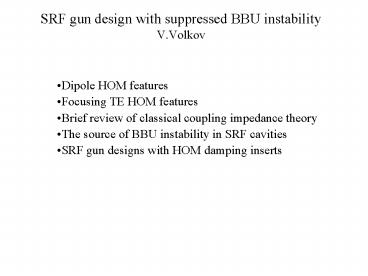SRF gun design with suppressed BBU instability V'Volkov - PowerPoint PPT Presentation
1 / 14
Title:
SRF gun design with suppressed BBU instability V'Volkov
Description:
TM dipole mode. Hybrid dipole mode ... [degree] Accuracy [%] 1. 1653. 405. 190. 282 -6.3. 1.4. 2. 1724 -363. 158. 925 -37.5. 0.9. 3. 1766 ... – PowerPoint PPT presentation
Number of Views:55
Avg rating:3.0/5.0
Title: SRF gun design with suppressed BBU instability V'Volkov
1
SRF gun design with suppressed BBU
instabilityV.Volkov
- Dipole HOM features
- Focusing TE HOM features
- Brief review of classical coupling impedance
theory - The source of BBU instability in SRF cavities
- SRF gun designs with HOM damping inserts
2
Dipole HOM features
TE dipole mode
TM dipole mode
Both have magnetic fields at the axis
Orthogonal transverse electric and magnetic
fields and linear increased in orthogonal
directions longitudinal ones close to axis
Hybrid dipole mode have longitudinal fields
increased linearly due to curvature of force lines
3
Dipole HOM features
Dipole HOMs in the SRF gun cavity.
The HOM trapped into the 1st cavity cell and well
coupled with the cathode Cu stem that suppress
its quality on 1 order of value up to Qext108.
Trapped HOMs have their frequen-cies higher
cutoff frequency of beam pipe but can not free
transmit there to the load.
4
Dipole HOM features
Cavity length detuning
Some trapped qualities
In the simulation, all waves incident into the
pipe dissipates in the load fully without any
reflection.
Transversal voltages excited by 1 mA beam vs.
length detuning
To avoid resonance voltages while the detuning we
must switch the repetition frequency or speed up
the detuning at the resonances.
5
Focusing TE HOMs features
TE mode used in the simulation
Effective variants of TE modes for beam focusing
p mode
p/2 mode (stable)
0 mode
6
Focusing TE HOMs features
Fourier oscillating part of focusing force
Zero oscillating part at some frequencies for
symmetrical B-field distribution
Axis B-field distribution
PHYSICAL REVIEW SPECIAL TOPICS - ACCELERATORS
AND BEAMS 11, 061302 (2008)
7
Brief review of classical coupling impedance
theory
Equivalent scheme of dipole voltage excitations
8
The source of BBU instability in SRF cavities
Actual trajectory oscillation ?Y in the SRF
cavity are the source of BBU instability
Since DUDYB, and DYB then DUB2, i.e. DUJ
together with excitation power that is
PexcIbeamDU
DUU0U1cos(f)U2cos(2fF)
Since the dissipated power is also PdisJ then
instability begins at Pexc Pdiss ?J/Q, i.e.
IthresholdQ?J/?U
PHYSICAL REVIEW SPECIAL TOPICS - ACCELERATORS
AND BEAMS 12, 011301 (2009)
9
The source of BBU instability in SRF cavities
Derivation of the formulas
Differential equation of the particle transverse
motion
The solution of the equation
The energy gain (?U) in the dipole mode
After replacing the y by its solution, we obtain
?UU0U1cos(f)U2cos(2fF)
10
The source of BBU instability in SRF cavities
Excitation voltages
Eacc6.25 MV/m
- U0,U2 are independent to U1
- U0,U2 J
- U1 is similar to classical case (straight line
trajectory)
Eacc25 MV/m
11
The source of BBU instability in SRF cavities
Threshold currents in SRF gun with TE mode
focusing
Eacc_6.25 MV/m. Threshold currents multiplied to
the HOM quality.
Eacc25 MV/m Threshold currents multiplied to
the HOM quality.
12
SRF gun designs with HOM damping inserts
13
SRF gun designs with HOM damping insert
Insert influence on HOM spectrums.
The spectrum without the insert is depicted by
red color, and with the insert by blue one.
14
SRF gun designs with HOM damping insert
Insert influence on threshold currents
Threshold currents mA for Emax25 MV/m with
and without insert (BTE0)
Threshold currents mA for Emax6.25 MV/m with
and without insert (BTE0)































